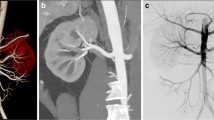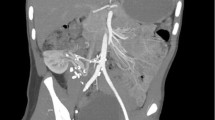Abstract
Objectives
Renovascular disease (RVD) is found in about 10 % of secondary childhood hypertension. Digital subtraction angiography (DSA) is the gold standard to diagnose RVD. Non-invasive imaging methods like Doppler ultrasound (US), magnetic resonance angiography (MRA), and computed tomography angiography (CTA) are increasingly used. Our aim was to evaluate the role and accuracy of US, MRA, and CTA compared to DSA in diagnosing RVD in children.
Patients and methods
A retrospective review of 127 children with suspected renovascular hypertension was performed in children referred to Great Ormond Street Hospital between 2006 and 2014 due to clinical suspicion of renovascular hypertension and/or findings on US and/or MRA or CTA.
Results
Ninety-nine of 127 children (78 %) were diagnosed with renovascular disease and 80 were treated with percutaneous transluminal angioplasty during the same procedure. The median age at presentation was 5.6 (range, 2.5–10.6) years. Thirty-six children had unilateral renal artery stenosis in major extraparenchymal vessels, 47 bilateral stenosis and 16 intrarenal small vessel disease. US had a sensitivity of 63 % and specificity of 95 %. MRA and CTA were performed in 39 and 34 children, respectively. CTA sensitivity was slightly higher than that of MRA, 88 vs. 80 %, and specificity 81 vs. 63 %.
Conclusions
The sensitivity of MRA and CTA is still too low to reliably rule out renovascular disease in children with a strong suspicion of this diagnosis. DSA remains the gold standard to diagnose renovascular hypertension and is recommended when clinical and laboratory criteria are highly suggestive of renovascular disease even with normal radiological investigations from non-invasive methods.

Similar content being viewed by others
Abbreviations
- CTA:
-
Computed tomography angiography
- DSA:
-
Digital subtraction angiography
- GOSH:
-
Great Ormond Street Hospital London
- IQR:
-
Interquartile range
- MRA:
-
Magnetic resonance tomography
- RAS:
-
Renal artery stenosis
- RVD:
-
Renovascular disease
- US:
-
Doppler ultrasound
References
Gill DG, Mendes de Costa B, Cameron JS, Joseph MC, Ogg CS, Chantler C (1976) Analysis of 100 children with severe and persistent hypertension. Arch Dis Child 51:951–956
Wyszynska T, Cichocka E, Wieteska-Klimczak A, Jobs K, Januszewicz P (1992) A single pediatric center experience with 1025 children with hypertension. Acta Paediatr 81:244–246
Bayazit AK, Yalcinkaya F, Cakar N, Duzova A, Bircan Z, Bakkaloglu A, Canpolat N, Kara N, Sirin A, Ekim M, Oner A, Akman S, Mir S, Baskin E, Poyrazoglu HM, Noyan A, Akil I, Bakkaloglu S, Soylu A (2007) Reno-vascular hypertension in childhood: a nationwide survey. Pediatr Nephrol 22:1327–1333
Tullus K (2011) Renal artery stenosis: is angiography still the gold standard in 2011? Pediatr Nephrol 26:833–837
Tullus K, Brennan E, Hamilton G, Lord R, McLaren CA, Marks SD, Roebuck DJ (2008) Renovascular hypertension in children. Lancet 371:1453–1463
Brun P, Kchouk H, Mouchet B, Baudouin V, Raynaud A, Loirat C, Azancot-Benisty A (1997) Value of Doppler ultrasound for the diagnosis of renal artery stenosis in children. Pediatr Nephrol 11:27–30
Conkbayir I, Yucesoy C, Edguer T, Yanik B, Yasar Ayaz U, Hekimoglu B (2003) Doppler sonography in renal artery stenosis. An evaluation of intrarenal and extrarenal imaging parameters. Clin Imaging 27:256–260
Eklof H, Ahlstrom H, Magnusson A, Andersson LG, Andren B, Hagg A, Bergqvist D, Nyman R (2006) A prospective comparison of duplex ultrasonography, captopril renography, MRA, and CTA in assessing renal artery stenosis. Acta Radiol 47:764–774
Frush DP (2008) Pediatric abdominal CT angiography. Pediatr Radiol 38(Suppl 2):S259–266
Rountas C, Vlychou M, Vassiou K, Liakopoulos V, Kapsalaki E, Koukoulis G, Fezoulidis IV, Stefanidis I (2007) Imaging modalities for renal artery stenosis in suspected renovascular hypertension: prospective intraindividual comparison of color Doppler US, CT angiography, GD-enhanced MR angiography, and digital substraction angiography. Ren Fail 29:295–302
Sabharwal R, Vladica P, Coleman P (2007) Multidetector spiral CT renal angiography in the diagnosis of renal artery fibromuscular dysplasia. Eur J Radiol 61:520–527
Hacklander T, Mertens H, Stattaus J, Lurken M, Lerch H, Altenburg A, Rautenbach J, Cramer BM (2004) Evaluation of renovascular hypertension: comparison of functional MRI and contrast-enhanced MRA with a routinely performed renal scintigraphy and DSA. J Comput Assist Tomogr 28:823–831
Stacul F, Gava S, Belgrano M, Cernic S, Pagnan L, Pozzi Mucelli F, Cova MA (2008) Renal artery stenosis: comparative evaluation of gadolinium-enhanced MRA and DSA. Radiol Med 113:529–546
Tan KT, van Beek EJ, Brown PW, van Delden OM, Tijssen J, Ramsay LE (2002) Magnetic resonance angiography for the diagnosis of renal artery stenosis: a meta-analysis. Clin Radiol 57:617–624
Vo NJ, Hammelman BD, Racadio JM, Strife CF, Johnson ND, Racadio JM (2006) Anatomic distribution of renal artery stenosis in children: implications for imaging. Pediatr Radiol 36:1032–1036
Garel L, Dubois J, Robitaille P, Russo P, Filiatrault D, Grignon A, Dube J (1995) Renovascular hypertension in children: curability predicted with negative intrarenal Doppler US results. Radiology 195:401–405
Srinivasan A, Krishnamurthy G, Fontalvo-Herazo L, Nijs E, Meyers K, Kaplan B, Cahill AM (2011) Spectrum of renal findings in pediatric fibromuscular dysplasia and neurofibromatosis type 1. Pediatr Radiol 41:308–316
Deal JE, Snell MF, Barratt TM, Dillon MJ (1992) Renovascular disease in childhood. J Pediatr 121:378–384
Stringer DA, O’Halpin D, Daneman A, Liu P, Geary DF (1989) Duplex Doppler sonography for renal artery stenosis in the post-transplant pediatric patient. Pediatr Radiol 19:187–192
Williams GJ, Macaskill P, Chan SF, Karplus TE, Yung W, Hodson EM, Craig JC (2007) Comparative accuracy of renal duplex sonographic parameters in the diagnosis of renal artery stenosis: paired and unpaired analysis. Am J Roentgenol 188:798–811
Solar M, Zizka J, Krajina A, Michl A, Raupach J, Klzo L, Ryska P, Ceral J (2011) Comparison of duplex ultrasonography and magnetic resonance imaging in the detection of significant renal artery stenosis. Acta Med (Hradec Kralove) 54:9–12
Voiculescu A, Hofer M, Hetzel GR, Malms J, Modder U, Grabensee B, Hollenbeck M (2001) Noninvasive investigation for renal artery stenosis: contrast-enhanced magnetic resonance angiography and color Doppler sonography as compared to digital subtraction angiography. Clin Exp Hypertens 23:521–531
Distler A, Spies KP (1991) Diagnostic procedure in renovascular hypertension. Clin Nephrol 36:174–180
Postma CT, van Aalen J, de Boo T, Rosenbusch G, Thien T (1992) Doppler ultrasound scanning in the detection of renal artery stenosis in hypertensive patients. Br J Radiol 65:857–860
Strandness DE Jr (1990) Duplex scanning in diagnosis of renovascular hypertension. Surg Clin North Am 70:109–117
Chhadia S, Cohn RA, Vural G, Donaldson JS (2013) Renal Doppler evaluation in the child with hypertension: a reasonable screening discriminator? Pediatr Radiol 43:1549–1556
Kchouk H, Brun P, Sentou Y, Raynaud A, Gaux JC, Loirat C (1997) Renal stenosis in hypertensive children. Doppler/arteriographic correlation. J Mal Vasc 22:86–90
Castelli PK, Dillman JR, Kershaw DB, Khalatbari S, Stanley JC, Smith EA (2014) Renal sonography with Doppler for detecting suspected pediatric renin-mediated hypertension—is it adequate? Pediatr Radiol 44:42–49
Li JC, Wang L, Jiang YX, Dai Q, Cai S, Lv K, Qi ZH (2006) Evaluation of renal artery stenosis with velocity parameters of Doppler sonography. J Ultrasound Med 25:735–742, quiz 743–734
Glockner JF, Vrtiska TJ (2007) Renal MR and CT angiography: current concepts. Abdom Imaging 32:407–420
Vasbinder GB, Nelemans PJ, Kessels AG, Kroon AA, Maki JH, Leiner T, Beek FJ, Korst MB, Flobbe K, de Haan MW, van Zwam WH, Postma CT, Hunink MG, de Leeuw PW, van Engelshoven JM (2004) Accuracy of computed tomographic angiography and magnetic resonance angiography for diagnosing renal artery stenosis. Ann Intern Med 141:674–682, discussion 682
Vade A, Agrawal R, Lim-Dunham J, Hartoin D (2002) Utility of computed tomographic renal angiogram in the management of childhood hypertension. Pediatr Nephrol 17:741–747
Kurian J, Epelman M, Darge K, Meyers K, Nijs E, Hellinger JC (2013) The role of CT angiography in the evaluation of pediatric renovascular hypertension. Pediatr Radiol 43:490–501, quiz 487–499
Contributors’ statements
Agnes Trautmann: Dr. Trautmann designed the data collection, collected the data, carried out the initial analyses, drafted the initial manuscript and approved the final manuscript as submitted.
Derek Roebuck: Dr. Roebuck reviewed and revised the manuscript, and approved the final manuscript as submitted.
Clare A. McLaren: Ms. McLaren reviewed and revised the manuscript and approved the final manuscript as submitted.
Eileen Brennan: Ms. Eileen Brennan reviewed and revised the manuscript and approved the final manuscript as submitted.
Kjell Tullus: Dr. Tullus conceptualized and designed the study, supervised data collection, critically reviewed and revised the manuscript, and approved the final manuscript as submitted.
All authors approved the final manuscript as submitted and agree to be accountable for all aspects of the work.
Author information
Authors and Affiliations
Corresponding author
Ethics declarations
The retrospective study was performed in accordance with the ethical standards as laid down in the 1964 Declaration of Helsinki and its later amendments.
For this type of study formal consent is not required.
Conflict of interest
The authors declare that they have no conflicts of interest.
Rights and permissions
About this article
Cite this article
Trautmann, A., Roebuck, D.J., McLaren, C.A. et al. Non-invasive imaging cannot replace formal angiography in the diagnosis of renovascular hypertension. Pediatr Nephrol 32, 495–502 (2017). https://doi.org/10.1007/s00467-016-3501-7
Received:
Revised:
Accepted:
Published:
Issue Date:
DOI: https://doi.org/10.1007/s00467-016-3501-7




